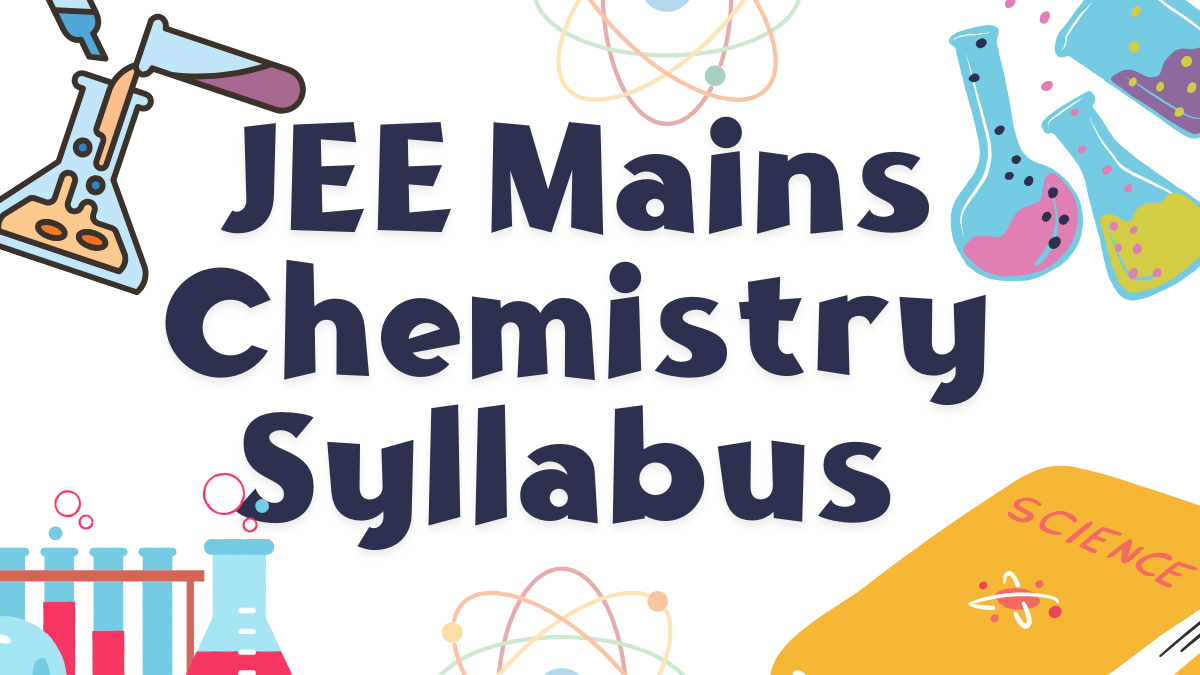The NTA will shortly release the JEE Mains 2026 Syllabus on its official website (jeemain.nta.nic.in). The National Testing Agency will keep the JEE Main Chemistry Syllabus largely the same. A few topics have been removed from the last year’s syllabus, the list is: Surface Chemistry, States of Matter, General Principles and Processes for the Isolation of Metals, s-block elements, Hydrogen, Environmental Chemistry, Alcohol, Phenol, and Ether, and Polymers. This article will give you a detailed JEE Main Chemistry Syllabus 2026.
JEE Mains Chemistry Syllabus 2026
The complete syllabus of the JEE Mains Chemistry is mentioned here, along with the topics and units that are covered in JEE Main. The Chemistry JEE Mains syllabus has been divided into three parts. Section A describes Physics and Chemistry; Section B describes Inorganic Chemistry; and Section C describes Organic Chemistry.
Students, have a look at the detailed JEE Mains Chemistry syllabus of the three sections:
Section A: Physical Chemistry
Topics covered under JEE Main Physical Chemistry 2026: Some Basic Concepts in Chemistry, Atomic Structure, Chemical Thermodynamics, Solutions, Chemical Kinetics, and many. The table given below will guide you properly:
|
Units |
Topics |
|
SOME BASIC CONCEPTS IN CHEMISTRY |
Matter and its nature, Dalton’s atomic theory, Concept of atom, molecule, element, and compound, Laws of chemical combination, Atomic and molecular masses, mole concept, molar mass, percentage composition, empirical and molecular formulae, Chemical equations, and stoichiometry. |
|
ATOMIC STRUCTURE |
Nature of electromagnetic radiation, photoelectric effect, spectrum of the hydrogen atom, Bohr model of a hydrogen atom – its postulates, derivation of the relations for the energy of the electron and radii of the different orbits, limitations of Bohr’s model, dual nature of matter, de Broglie’s relationship, Heisenberg uncertainty principle, elementary ideas of quantum mechanics, the quantum mechanical model of the atom and its important features, concept of atomic orbitals as one-electron wave functions, variation of ψ and ψ 2 with r for 1s and 2s orbitals, various quantum numbers (principal, angular momentum and magnetic quantum numbers) and their significance, shapes of s, p and d – orbitals, electron spin and spin quantum number, rules for filling electrons in orbitals – Aufbau principle, Pauli’s exclusion principle andHund’srule, electronic configuration of elements and extra stability of half-filled and filled orbitals. |
|
CHEMICAL BONDING AND MOLECULAR STRUCTURE |
Kossel-Lewis approach to chemical bond formation, the concept of ionic and covalent bonds. Ionic Bonding: Formation of ionic bonds, factors affecting the formation of ionic bonds; calculation of lattice enthalpy. Covalent Bonding: Concept of electronegativity, Fajan’s rule, dipole moment, Valence Shell Electron Pair Repulsion (VSEPR ) theory, and shapes of simple molecules. Quantum mechanical approach to covalent bonding: Valence bond theory – its important features, the concept of hybridisation involving s, p, and d orbitals, and resonance. Molecular Orbital Theory – Its important features, LCAOs, types of molecular orbitals (bonding, antibonding), sigma and pi-bonds, molecular orbital electronic configurations of homonuclear diatomic molecules, the concept of bond order, bond length and bond energy. An elementary idea of metallic bonding, hydrogen bonding, and their applications. |
|
CHEMICAL THERMODYNAMICS |
Fundamentals of thermodynamics: System and surroundings, extensive and intensive properties, state functions, entropy, types of processes. The first law of thermodynamics – Concept of work, heat, internal energy and enthalpy, heat capacity, molar heat capacity, Hess’s law of constant heat summation, Enthalpies of bond dissociation, combustion, formation, atomization, sublimation, phase transition, hydration, ionisation, and solution. The second law of thermodynamics – Spontaneity of processes, ΔS of the universe and ΔGof the system as criteria for spontaneity. ΔG°(Standard Gibbs energy change) and equilibrium constant. |
|
SOLUTIONS |
Different methods for expressing the concentration of solution – molality, molarity, mole fraction, percentage (by volume and mass both), the vapour pressure of solutions and Raoult’s Law- Ideal and nonideal solutions, vapour pressure – composition, plots for ideal and non- ideal solutions, Colligative properties of dilute solutions – a relative lowering of vapour pressure, depression of freezing point, the elevation of boiling point and osmotic pressure, determination of molecular mass using colligative properties, abnormal value of molar mass, van’t Hoff factor and its significance |
|
EQUILIBRIUM |
The meaning of equilibrium is the concept of dynamic equilibrium. Equilibria involving physical processes: Solid-liquid, liquid-gas, gas-gas and solid-gas equilibria, Henry’s law. General characteristics of equilibrium involving physical processes. Equilibrium involving chemical processes: Law of chemical equilibrium, equilibrium constants (Kp and Kc) and their significance, the significance of ΔG and ΔG° in chemical equilibrium, factors affecting equilibrium concentration, pressure, temperature, the effect of a catalyst, Le Chatelier’s principle. Ionic equilibrium: Weak and strong electrolytes, ionization of electrolytes, various concepts of acids and bases (Arrhenius, Bronsted – Lowry and Lewis) and their ionization, acid-base equilibria (including multistage ionization) and ionization constants, ionization of water, pH scale, common effect, hydrolysis of salts and pH of their solutions, the solubility of sparingly soluble salts, solubility products and buffer solutions. |
|
REDOX REACTIONS AND ELECTROCHEMISTRY |
Electronic concepts of oxidation and reduction, redox reactions, oxidation number, rules for assigning oxidation number and balancing of redox reactions. Electrolytic and metallic conduction, conductance in electrolytic solutions, molar conductivities and their variation with concentration, Kohlrausch’s law and its applications. Electrochemical cells – Electrolytic and Galvanic cells, different types of electrodes, electrode potentials including standard electrode potential, half-cell and cell reactions, emf of a Galvanic cell and its measurement, Nernst equation and its applications, relationship between cell potential and Gibbs’ energy change, dry cell and lead accumulator, fuel cells. |
|
CHEMICAL KINETICS |
Rate of a chemical reaction, factors affecting the rate of reactions: concentration, temperature, pressure and catalyst, elementary and complex reactions, order and molecularity of reactions, rate law, rate constant and its units, differential and integral forms of zero and first-order reactions, their characteristics and half-lives, the effect of temperature on the rate of reactions, Arrhenius theory, activation energy and its calculation, collision theory of bi-molecular gaseous reactions (no derivation). |
Section B: Inorganic Chemistry
The JEE Main Inorganic Chemistry syllabus 2026 includes Classification of Elements and Periodicity in Properties, P-Block Elements, D and F-Block Elements, and Coordination Compounds.
|
Units |
Topics |
|
CLASSIFICATION OF ELEMENTS AND PERIODICITY IN PROPERTIES |
Modern periodic law and present form of the periodic table, s, p., d, and f block elements, periodic trends in properties of elements of atomic and ionic radii, ionisation enthalpy, electron gain enthalpy, valence, oxidation states, and chemical reactivity. |
|
p- BLOCK ELEMENTS |
Group -13 to Group 18 Elements General Introduction: Electronic configuration and general trends in physical and chemical properties of elements across the periods and down the groups, unique behaviour of the first element in each group. |
|
d – and f- BLOCK ELEMENTS |
Transition Elements – General introduction, electronic configuration, occurrence and characteristics, general trends in properties of the first-row transition elements – physical properties, ionisation enthalpy, oxidation states, atomic radii, colour, catalytic behaviour, magnetic properties, complex formation, interstitial compounds, alloy formation, preparation, properties and uses of K2Cr2O7 and KMnO4. Inner Transition Elements Lanthanoids – Electronic configuration, oxidation states, and Lanthanoid contraction. Actinoids – Electronic configuration and oxidation states. |
|
COORDINATION COMPOUNDS |
Introduction to coordination compounds. Werner’s theory, ligands, coordination number, denticity, chelation, IUPAC nomenclature of mononuclear coordination compounds, isomerism, Bonding: Valencebond approach and basic ideas of Crystal field theory, colour and magnetic properties, importance of coordination compounds (in qualitative analysis, extraction of metals and in biological systems). |
Section C: Organic Chemistry
Section C contains topics like Halogens, Purification and Characterisation of Organic Compounds, Biomolecules, Principles of Practical Chemistry, etc. The mentioned table will provide you with details:
|
Units |
Topics |
|
PURIFICATION AND CHARACTERISATION OF ORGANIC COMPOUNDS |
Purification – Crystallisation, sublimation, distillation, differential extraction, and chromatography-principles and their applications. Qualitative analysis – Detection of nitrogen, sulphur, phosphorus and halogens. Quantitative analysis (basic principles only) – Estimation of carbon, hydrogen, nitrogen, halogens, sulphur and phosphorus. Calculations of empirical formulae and molecular formulae, numerical problems in organic quantitative analysis, |
|
SOME BASIC PRINCIPLES OF ORGANIC CHEMISTRY |
Tetravalency of carbon, shapes of simple molecules – hybridisation (s and p): classification of organic compounds based on functional groups and those containing halogens, oxygen, nitrogen and sulphur, homologous series: Isomerism – structural and stereoisomerism. Nomenclature (Trivial and IUPAC) Covalent bond fission – Homolytic and heterolytic, free radicals, carbocations and carbanions, stability of carbocations and free radicals, electrophiles and nucleophiles. Electronic displacement in a covalent bond – Inductive effect, electromeric effect, resonance and hyperconjugation. Common types of organic reactions- Substitution, addition, elimination and rearrangement. |
|
HYDROCARBONS |
Classification, isomerism, IUPAC nomenclature, general methods of preparation, properties, and reactions. Alkanes – Conformations: Sawhorse and Newman projections (of ethane), mechanism of halogenation of alkanes. Alkenes – Geometrical isomerism, mechanism of electrophilic addition, addition of hydrogen, halogens, water, hydrogen halides (Markownikoff’s and peroxide effect), Ozonolysis, and polymerisation. Alkynes – Acidic character, addition of hydrogen, halogens, water, and hydrogen halides, polymerisation. Aromatic hydrocarbons – Nomenclature, benzene – structure and aromaticity, mechanism of electrophilic substitution, halogenation, nitration. Friedel-Craft’s alkylation and acylation, the directive influence of the functional group in mono-substituted benzene. |
|
ORGANIC COMPOUNDS CONTAINING HALOGENS |
General methods of preparation, properties, and reactions, nature of the C-X bond, mechanisms of substitution reactions. Uses, environmental effects of chloroform, iodoform, freons, and DDT. |
|
ORGANIC COMPOUNDS CONTAINING OXYGEN |
General methods of preparation, properties, reactions, and uses. ALCOHOLS, PHENOLS, AND ETHERS Alcohols: Identification of primary, secondary, and tertiary alcohols, mechanism of dehydration. Phenols: Acidic nature, electrophilic substitution reactions, halogenation, nitration, and sulphonation, Reimer-Tiemann reaction. Ethers: Structure. Aldehyde and Ketones: Nature of carbonyl group, nucleophilic addition to > C=O group, relative reactivities of aldehydes and ketones, important reactions such as – Nucleophilic addition reactions(addition of HCN, NH3 and its derivatives), Grignard reagent, oxidation, reduction (Wolf Kishner andClemmensen), the acidity of α-hydrogen. Aldol condensation, Cannizzaro reaction, Haloform reaction, and chemical tests to distinguish between aldehydes and ketones. Carboxylic Acids: Acidic strength and factors affecting it |
|
ORGANIC COMPOUNDS CONTAINING NITROGEN |
General methods of preparation, properties, reactions and uses. Amines: Nomenclature, classification, structure, basic character, and identification of primary, secondary and tertiary amines and their basic character. Diazonium Salts: Importance in Synthetic Organic Chemistry. UNIT 19: BIOMOLECULES General introduction and importance of biomolecules. CARBOHYDRATES – Classification, aldoses and ketoses, monosaccharides (glucose and fructose), and constituent monosaccharides of oligosaccharides (sucrose, lactose and maltose). PROTEINS – Elementary idea of α α-α-amino acids, peptide bond, polypeptides, proteins: primary, secondary, tertiary and quaternary structure (qualitative idea only), denaturation of proteins, enzymes. VITAMINS – Classification and functions. NUCLEIC ACIDS – Chemical constitution of DNA and RNA, biological functions of nucleic acids. Hormones (General introduction) |
|
PRINCIPLES RELATED TO PRACTICAL CHEMISTRY |
Detection of extra elements (Nitrogen, sulphur, halogens) in organic compounds, detection of the following functional groups: hydroxyl (alcoholic and phenolic), carbonyl (aldehyde and ketones), carboxyl and amino groups in organic compounds. The chemistry involved in the preparation of the following: Inorganic compounds, Mohr’s salt, potash alum. Organic compounds: Acetanilide, p-nitro acetanilide, aniline yellow, iodoform. The chemistry involved in the titrimetric exercises – acids, bases and the use of indicators, oxalic acid vs KMnO4, Mohr’s salt vs KMnO4. Chemical principles involved in the qualitative salt analysis: Cations – Pb²⁺, Cu²⁺, Al³⁺, Fe³⁺, Zn²⁺, Ni²⁺, Ca²⁺, Ba²⁺, Mg²⁺, NH₄⁺ Anions – CO₃²⁻, S²⁻, SO₄²⁻, NO₃⁻, NO₂⁻, Cl⁻, Br⁻, I⁻ ( Insoluble salts excluded). Chemical principles involved in the following experiments: 1. Enthalpy of solution of CuSO4 2. Enthalpy of neutralisation of a strong acid and a strong base. 3. Preparation of lyophilic and lyophobic sols. 4. Kinetic study of the reaction of iodide ions with hydrogen peroxide at room temperature. |
Chapter-wise weightage for JEE Mains Chemistry 2026
Understanding JEE 2026 chapter-wise weightage has been done thoroughly by analysing the last 5 years’ question papers. Chemistry is basically made up of three major parts: organic, Inorganic, and Physical Chemistry. The chapter-wise break-up in terms of total questions and the respective weights will familiarise the students with the complete study material.
| S.No | Topic | Weightage (%) |
|---|---|---|
| 1 | Coordination Compounds | 5.33% |
| 2 | Hydrocarbons | 3.03% |
| 3 | Some Basic Concepts of Chemistry | 2.82% |
| 4 | Chemical Kinetics | 3.61% |
| 5 | The d and f-Block Elements | 4.69% |
| 6 | Chemical Bonding and Molecular Structure | 3.34% |
| 7 | Aldehydes, Ketones and Carboxylic Acids | 5.95% |
| 8 | Atomic Structure | 3.34% |
| 9 | Alcohols, Phenols and Ethers | 3.54% |
| 10 | Redox Reaction | 1.75% |
| 11 | Electrochemistry | 3.30% |
| 12 | Amines | 4.40% |
| 13 | Solutions | 4.54% |
| 14 | s-Block Elements | 4.16% |
| 15 | Surface Chemistry | 2.99% |
| 16 | Some Basic Principles and Techniques: General Organic Chemistry | 1.20% |
| 17 | The p-Block Elements (Group 15 to 18) | 3.68% |
| 18 | Hydrogen | 2.82% |
| 19 | Purification and Analysis of Organic Compounds | 1.94% |
| 20 | The Solid State | 1.72% |
| 21 | Equilibrium | 4.44% |
| 22 | Biomoolecules | 3.99% |
| 23 | Polymers | 2.06% |
| 24 | Environmental Chemistry | 2.99% |
| 25 | Haloalkanes and Haloarenes | 2.65% |
| 26 | General Principles and Processes of Isolation of Metals | 3.37% |
| 27 | The p-Block Elements | 1.79% |
| 28 | Some Basic Principles and Techniques: IUPAC Nomenclature | 0.10% |
| 29 | Some Basic Principles and Techniques: Isomerism | 0.27% |
| 30 | Chemical Thermodynamics and Energetics | 3.65% |
| 31 | Principles of Inorganic Qualitative Analysis: Salt Analysis | 0.50% |
| 32 | States of Matter | 1.89% |
Preparation Books For JEE Mains Chemistry Syllabus 2026
Some of the books for preparation are: For classes 11 and 12, you can practice the NCERT only, but to study in more detail, you can prefer these books:
- IT Chemistry and Physical Chemistry- OP Tandon
- Organic Chemistry- Morrison and Boyd
- Numerical Chemistry- P. Bahadur
- Concise Inorganic Chemistry- J.D. Lee
- You can prefer these books to score well in the exam.










 CBSE Admit Card 2026 for Private & R...
CBSE Admit Card 2026 for Private & R...
 AILET 2026 AIR 1: Check Full Toppers Lis...
AILET 2026 AIR 1: Check Full Toppers Lis...
 AILET Result 2026 OUT, How to Download S...
AILET Result 2026 OUT, How to Download S...














